

Why Creative People Sometimes Make No Sense – Matthew Schuler. Photo by Sophia.
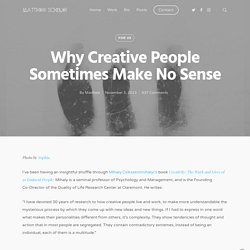
I’ve been having an insightful shuffle through Mihaly Csikszentmihalyi’s book Creativity: The Work and Lives of 91 Eminent People. Mihaly is a seminal professor of Psychology and Management, and is the Founding Co-Director of the Quality of Life Research Center at Claremont. He writes: “I have devoted 30 years of research to how creative people live and work, to make more understandable the mysterious process by which they come up with new ideas and new things.
If I had to express in one word what makes their personalities different from others, it’s complexity. Nine out of the ten people in me strongly agree with that statement. Mihaly describes 9 contradictory traits that are frequently present in creative people: Most creative people have a great deal of physical energy, but are often quiet and at rest. Most creative people tend to be smart and naive at the same time. Innovation. Creation history: brilliant ideas build on the past. To understand one of the secrets of creativity, just peek into an art classroom in Denver, Colorado.

The teacher asks her pupils to imitate the style of Vassily Kandinsky. The students mimic Kandinsky’s geometric abstractions, mastering brushwork and learning colour theory. If that was all there was to the lesson, it would be a hands-on class in art history. But the art teacher asks the students to cut up their paintings and build 3D sculptures out of the pieces. They have all started with the same source, but their works all end up looking extremely different: some rise straight up in a column, while others are a jigsaw of different forms and angles.
The GamePlan A Guide to Creativity. Brace yourself for the truth: creativity has no perfect blueprint to follow.

It’s less about formula, more about trial and error. While creativity is accessible to all, it’s elusive to most. We never really know when that “Aha!” Moment is going to come – if ever. We don’t always understand the creative process, but we appreciate it when we see it. From idea to innovation – but how? Imagination Quotes - iPerceptive. Creative. Expand Your Imagination Exponentially. Develop Your Imagination. Janet Echelman: Taking imagination seriously. Critical Thinking and Questioning.
The differences between imagination, creativity, and innovation. Posted May 18th, 2015 by Tanner Christensen Like any toolbox, our minds have an assortment of tools available for us to utilize whenever we need to.
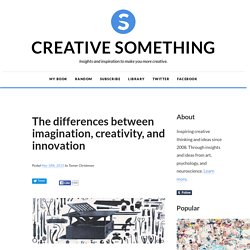
Included in our mental toolbox are cognitive processes, clusters of which compose of three primary ones involved in ideation: imagination, creativity, and innovative thinking. Unless we know the differences between the tools at our disposal, we may find ourselves attempting to hammer in a nail using a screwdriver. It might get the job done, but it’s definitely not ideal.
Imagination is about seeing the impossible, or unreal. Typically, we often confuse these three for one or the other. Dreams at night are a type of imaginative thinking; what you see when you dream isn’t really happening, and in most instances what you dream cannot physically happen. When solving a novel problem at work or school, we rely on creativity to generate an answer or idea for overcoming the problem. With imagination, our focus can be on things that are impossible. Divergent Thinking. Creative Confidence. Art Creativity Music. Augmented Reality. Academic Skills. Creative Tools and Resources. Joni Mitchell on Therapy and the Creative Mind. By Maria Popova It’s paradoxical that while “art holds out the promise of inner wholeness” for those who experience it, the relationship between creativity and mental illness is well-documented among those who make it, as is the anguish of artists who experience it.
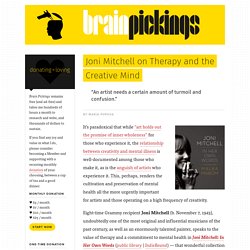
This, perhaps, renders the cultivation and preservation of mental health all the more urgently important for artists and those operating on a high frequency of creativity. Eight-time Grammy recipient Joni Mitchell (b. November 7, 1943), undoubtedly one of the most original and influential musicians of the past century, as well as an enormously talented painter, speaks to the value of therapy and a commitment to mental health in Joni Mitchell: In Her Own Words (public library | IndieBound) — that wonderful collection of wide-ranging conversations by musician, documentarian, and broadcast journalist Malka Marom, which also gave us Mitchell on freedom, creativity, and the dark side of success. Creative Inspiration. What happens in the brain when you learn a language? Learning a foreign language can increase the size of your brain.

This is what Swedish scientists discovered when they used brain scans to monitor what happens when someone learns a second language. The study is part of a growing body of research using brain imaging technologies to better understand the cognitive benefits of language learning. Tools like magnetic resonance imaging (MRI) and electrophysiology, among others, can now tell us not only whether we need knee surgery or have irregularities with our heartbeat, but reveal what is happening in our brains when we hear, understand and produce second languages. The Swedish MRI study showed that learning a foreign language has a visible effect on the brain. Creativity Is Much More Than 10,000 Hours of Deliberate Practice. In his new book "Peak: Secrets from the New Science of Expertise", psychologist Anders Ericsson and journalist Robert Pool distill an impressive body of research on "mastering almost any skill.
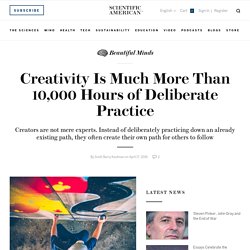
" Indeed, deliberate practice can help you master new skills. Deliberate practice involves a series of techniques designed to learn efficiently and purposefully. This involves goal setting, breaking down complex tasks into chunks, developing highly complex and sophisticated representations of possible scenarios, getting out of your comfort zone, and receiving constant feedback. But as they note midway through their book -- and I believe this is a really important caveat-- the techniques of deliberate practice are most applicable to "highly developed fields" such as chess, sports, and musical performance in which the rules of the domain are well established and passed on from generation to generation.
Creativity & Idea Generation. Joseph Conrad on Writing and the Role of the Artist. Tim Harford: How frustration can make us more creative. Creativity for children. Use your head. 449ce6 1032179887dd40fd893c1bc1d1ee5652. Creativity Research Guilford. 449ce6 84b834571b5349c0bcd96e5b1a6d899d. Author-blog-1. Creation Tools. Creative Process. Creativity and Courage, Failure. Full text of "The Act of Creation, Arthur Koestler.pdf (PDFy mirror)" Creativity. Creative. Debunking the Eureka Moment: Creative Thinking Is a Process. In 1666, one of the most influential scientists in history was strolling through a garden when he was struck with a flash of creative brilliance that would change the world.

While standing under the shade of an apple tree, Sir Isaac Newton saw an apple fall to the ground. “Why should that apple always descend perpendicularly to the ground,” Newton wondered. “Why should it not go sideways, or upwards, but constantly to the earth’s center? Assuredly, the reason is, that the earth draws it. There must be a drawing power in matter.” And thus, the concept of gravity was born. Creative thinking. Re-Imagining Work. Living in an Imaginary World. When Rachel Stein (not her real name) was a small child, she would pace around in a circle shaking a string for hours at a time, mentally spinning intricate alternative plots for her favorite television shows.
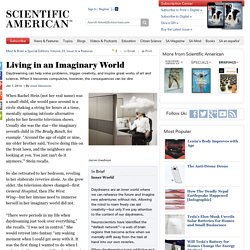
Usually she was the star—the imaginary seventh child in The Brady Bunch, for example. “Around the age of eight or nine, my older brother said, ‘You're doing this on the front lawn, and the neighbors are looking at you. You just can't do it anymore,’” Stein recalls. So she retreated to her bedroom, reveling in her elaborate reveries alone. As she grew older, the television shows changed—first General Hospital, then The West Wing—but her intense need to immerse herself in her imaginary world did not. “There were periods in my life when daydreaming just took over everything,” she recalls.
7 Tenets of Creative Thinking. In school, we learn about geniuses and their ideas, but how did they get those ideas?
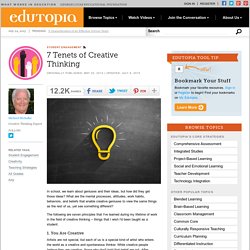
What are the mental processes, attitudes, work habits, behaviors, and beliefs that enable creative geniuses to view the same things as the rest of us, yet see something different? The following are seven principles that I've learned during my lifetime of work in the field of creative thinking -- things that I wish I'd been taught as a student. 1. You Are Creative Artists are not special, but each of us is a special kind of artist who enters the world as a creative and spontaneous thinker. 2. Créativité. Watch Creativity and Learning: A Conversation with Lynda Barry Online Video Course. All right. Today's talk is actually going to focus on the importance of the arts and how it fosters empathy and I don't have her formal bio written. The creative spark. Where do ideas come from? Advice from the Experts. Yes, You Can Teach and Assess Creativity!
A recent blog by Grant Wiggins affirmed what I have long believed about creativity: it is a 21st-century skill we can teach and assess. Creativity fosters deeper learning, builds confidence and creates a student ready for college and career. However, many teachers don't know how to implement the teaching and assessment of creativity in their classrooms. While we may have the tools to teach and assess content, creativity is another matter, especially if we want to be intentional about teaching it as a 21st-century skill. In a PBL project, some teachers focus on just one skill, while others focus on many. Here are some strategies educators can use tomorrow to get started teaching and assessing creativity -- just one more highly necessary skill in that 21st-century toolkit.
Quality Indicators. The Science (and Practice) of Creativity. "Creativity isn't about music and art; it is an attitude to life, one that everybody needs," wrote the University of Winchester's Professor Guy Claxton in the lead-up to the 2014 World Innovation Summit for Education (WISE) dedicated to creativity and education. "It is a composite of habits of mind which include curiosity, skepticism, imagination, determination, craftsmanship, collaboration, and self-evaluation. " Sounds like the perfect skill set for equipping young people to navigate an increasingly complex and unpredictable world. Encouragingly, there's plenty of evidence -- from both research and practice -- that most of the above can be taught in the classroom.
How Mind-Wandering and “Positive Constructive Daydreaming” Enhance Creativity and Improve Our Social Skills. By Maria Popova The science of why fantasy and imaginative escapism are essential elements of a satisfying mental life. Freud asserted that daydreaming is essential to creative writing — something a number of famous creators and theorists intuited in asserting that unconscious processing is essential to how creativity works, from T. S. Eliot’s notion of “idea incubation” to Alexander Graham Bell’s “unconscious cerebration” to Lewis Carroll’s “mental mastication.”
In the 1950s, Yale psychologist Jerome L. Ink & Stains. Theories and Observations. Combinatorial Creativity. Imagination. The Art of Looking: What 11 Experts Teach Us about Seeing Our Familiar City Block with New Eyes. By Maria Popova “Attention is an intentional, unapologetic discriminator. Networked Knowledge and Combinatorial Creativity. By Maria Popova. Ray Bradbury on Writing, Emotion vs. Intelligence, and the Core of Creativity.
By Maria Popova “You can only go with loves in this life.” Creativity Innovation Genius. Blooms-taxonomy-action-verbs.jpg (JPEG Image, 1275 × 1650 pixels) - Scaled (60%) What is Creativity? Creative Tools and Techniques - Enchanted Mind. The seven most effective techniques for creativity (backed by real data) The seven most effective techniques for creativity (backed by real data) The Science (and Practice) of Creativity. 27 creativity and innovation tools - in one-pagers!
Creativity Tools for Developing Creative Solutions from MindTools.com. How Walking Fosters Creativity: Stanford Researchers Confirm What Philosophers and Writers Have Always Known. Image via Diego Sevilla Ruiz A certain Zen proverb goes something like this: "A five year old can understand it, but an 80 year old cannot do it. " The subject of this riddle-like saying has been described as "mindfulness"---or being absorbed in the moment, free from routine mental habits.
In many Eastern meditative traditions, one can achieve such a state by walking just as well as by sitting still—and many a poet and teacher has preferred the ambulatory method. This is equally so in the West, where we have an entire school of ancient philosophy—the "peripatetic"—that derives from Aristotle and his contemporaries' penchant for doing their best work while in leisurely motion.
25 Creative Writing Prompts. The Creativity Post. The Five Major Theories of Creativity. Why We Have Our Best Ideas in the Shower: The Science of Creativity - - The Buffer Blog. “I’m not really a creative person”, always struck me as an odd sentence. Why Time Slows Down When We’re Afraid, Speeds Up as We Age, and Gets Warped on Vacation.
Combinatorial Creativity and the Myth of Originality. How to live with robots. The creative spark. Kickstart your creativity. 9 trippy TED Talks. Creativity. CREATIVE. Why “Psychological Androgyny” Is Essential for Creativity. By Maria Popova. The creative spark. Personal Archives. The Creativity Mindset. How melancholy expands our capacity for creativity, the best science books of the year, beautifully untranslatable words from around the world & more. Where do ideas come from?
Networked Knowledge and Combinatorial Creativity. Do You Have A Wandering Mind? The Difference Between Knowledge and Experience. Why We Have Our Best Ideas in the Shower: The Science of Creativity - - The Buffer Blog. Why Creativity Necessitates Eclecticism: Nick Cave’s Influences and Inspirations. How Einstein Thought: Why “Combinatory Play” Is the Secret of Genius. Pete Seeger on Combinatorial Creativity, Originality, Equality, and the Art of Dot-Connecting.